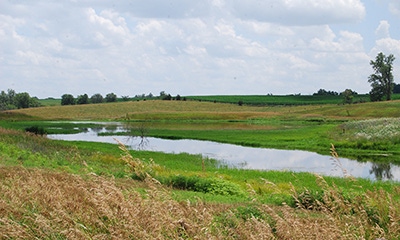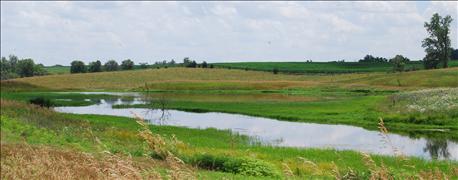May 10, 2016

Three farms in the Blanchard River Watershed have been selected by the Ohio Farm Bureau Federation and the United States Department of Agriculture Natural Resources Conservation Service (NRCS) to serve as demonstration farms to showcase new and innovative conservation practices that reduce and prevent nutrient run-off.

Demonstration farms advance water quality, productive farming
The farms, in Hancock and Hardin counties, are Kellogg Farms, Forest; Kurt Farm, Dunkirk; and Stateler Farm, McComb. These demonstration farms will serve as models to share new conservation techniques and practices with farmers, land managers, the media and the public. The demonstration farms are a key component of Ohio Farm Bureau’s Water Quality Action Plan, a comprehensive initiative to help farmers proactively improve and protect water quality while maintaining viable farming practices.
The Kellogg Farm project covers 305 acres in a corn/soybean rotation. This site will focus heavily on subsurface nutrient placement and its effect on yields. It also will look at potential fertilizer savings using different methods, timing and placements of cover crops. Other potential practices will include controlled traffic, conservation tillage, and proper storage facilities for on-site fertilizer and fuel tanks. An abandoned water well that is located within the crop field also will be removed.
On Kurt Farm, 168 acres of corn/soybean fields will be utilized. The project will monitor the effect on water quality of a two-stage ditch that was constructed previously with assistance from The Nature Conservancy. Other studies may look at subsurface placement of nutrients, plus no till, cover crops, blind inlets, filter strips and nutrient removal technologies. Also planned is the removal of an abandoned gas well.
The Stateler project includes 208 acres in a corn, soybean and wheat rotation plus a swine wean to finish operation. This site will focus on managing nutrients associated with modern animal agriculture. In addition to existing conservation practices, other practices to be considered are intensive soil testing, drainage water management, tile water treatment systems, paired edge of field testing, alternative cropping rotations, and variable rate nutrient placement. An animal mortality composting facility is also being proposed.
Farms were selected to reflect the makeup of agriculture in the watershed regarding crops and livestock, farm sizes, soil types, topography and current farming practices. Going forward, the landowners and farmers will install conservation systems to monitor farm inputs and outputs including nutrient levels, annual application rates and the methods and timing of applications. Ohio Farm Bureau also will develop strategies in which to share the innovative practices that are identified.
NRCS will provide eligible farm operators with financial assistance through conservation program contracts for conservation system implementation and will provide technical guidance to the advisory committee. NRCS also will provide conservation experts to speak during field days and other outreach events.
This project is also being supported by federal, state and local partners including:
• Hardin and Hancock Soil and Water Conservation Districts
• Blanchard River Watershed Partnership
• Ohio Federation of Soil and Water Conservation Districts
• The Nature Conservancy in Ohio
• Ohio Department of Natural Resources
• The Ohio State University
• USDA Agricultural Research Service
• USDA Natural Resources Conservation Service
• U.S. Geological Service
• OSU Extension
• Ohio Environmental Protection Agency
• Ohio Department of Agriculture
You May Also Like




